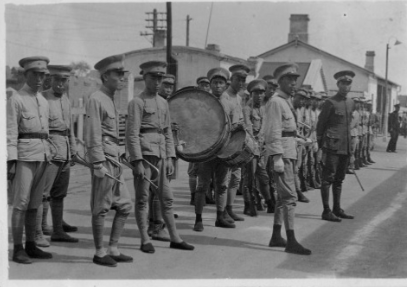“Manchukuo Troops”, 1932/1937, Manchuria, Albert E. Kane
Everyone is familiar with the saying, “a picture is worth a thousand words”. In today’s standards, where everyone has a phone camera in their back pocket, this phrase has lost it’s worth. Each person has hundreds of digital saved photos right at their fingertips. But the saying wasn’t meant for the world of 2023. Further back in history, photographs were more special. Knowing you had to take the time to properly develop a roll of film meant that what you were taking a photo of was important. And the wonderful thing is, we can look at a person’s travel pictures from years ago and it can tell us so much about that era. Digital archives provide literal snapshots from a distant time. Using a digital archive, I am able to endlessly analyze a photograph of Japanese soldiers just by observing it.
The photo I chose depicts the army in Manchuria, China. This tells the viewer that this snapshot was taken during the Japanese occupation in World War II. An article describing this time in history explains that Japan was, “faced with severe shortages of oil and other natural resources”, which motivated them to expand their empire (“World War II in the Pacific”). They decided to target Manchuria in China, but the Japanese needed a reason to break their current peace treaty. Although exactly who planted the explosives is still unknown, a track from a Japanese-owned railway in Manchuria exploded. The United States Office of Historian describes the aftermath of the Mukden Incident: “Within a few short months, the Japanese Army had overrun the region, having encountered next to no resistance from an untrained Chinese Army, and it went about consolidating its control on the resource-rich area.” (“The Mukden Incident of 1931 and the Stimson Doctrine”). Manchuria was just the first of many places that the Japanese would invade during the second World War. The Japanese were not known to be particularly kind either. A testimony from a survivor of this time recalled that the Japanese army broke into her family’s house, beat her mother, and tortured her father (“The Lives They Live: Surviving the Japanese Occupation”). Another striking story from this woman was that she saw a wagon full of people’s heads being wheeled by the Japanese. Needless to say, the Japanese were powerful and dangerous. I would imagine seeing the army in person must have been a terrifying sight to see. But according to the photograph, perhaps not entirely.
The soldiers in this troop appear to be disengaged and at rest, as seen by their posture and bored faces. But more striking than that, these soldiers appear to be very young men. Most of them don’t look older than 20 years of age. Upon researching, I discovered that every male as young as 16 years old were forced to be a part of the armed forces (“There Are No Civilians in Japan”). This means that literal children were performing war crimes in other countries. The troop’s youth is especially present in this photo. I wonder how many of these troops were in Manchuria. I wish I could ask the photographer if he took a picture of them because there were so many of them in the city or so few. Overall, the Japanese army must have been a shock to see, so I imagine the photographer wanted to document the army’s presence in Manchuria.
I found it interesting that the title of this photograph in the digital archives is “Manchukuo Troops”, as that word isn’t the same as “Manchuria”. This is because the Japanese changed the name of the town during their occupation to prove their control, mainly to other countries. Manchukuo is a Japanese version of the word Manchuria.
The photo itself is in black-and-white, but I can’t imagine what it must have been like to the troops in full color, right in front of you. Based on the location and time period, I was able to decipher the context of this picture. It tells a story, one of fear and conquest that actually occurred. Without images like these, we wouldn’t have as great an understanding of history. Digital archives showcase events, people, location, and more. In this way, a picture is truly worth a thousand words.
Works Cited
“The Mukden Incident of 1931 and the Stimson Doctrine”. Office of the Historian, Foreign Service Institute,
https://history.state.gov/milestones/1921-1936/mukden-incident
“The Lives They Live: Surviving the Japanese Occupation”. The Straits Times, November, 15, 2017,
“There Are No Civilians in Japan”. The National WWII Museum, August 4, 2020,
https://www.nationalww2museum.org/war/articles/there-are-no-civilians-japan#:~:text=The%20Japanese%20armed%20forces%20burgeoned,female%20age%2017%20to%2040
“WORLD WAR II IN THE PACIFIC”. United States Holocaust Memorial Museum,
https://encyclopedia.ushmm.org/content/en/article/world-war-ii-in-the-pacific#:~:text=Faced%20with%20severe%20shortages%20of,the%20resources%20of%20Southeast%20Asia
